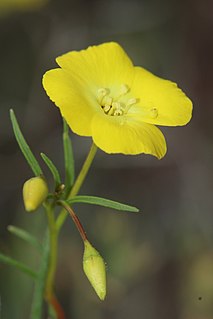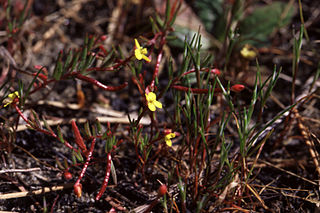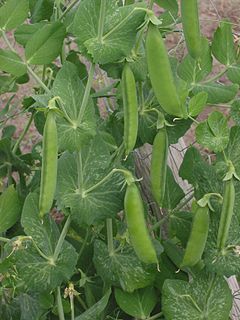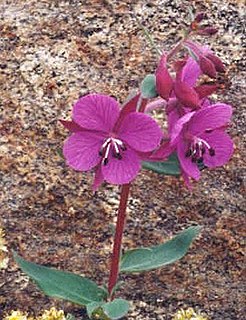
Dasiphora fruticosa is a species of hardy deciduous flowering shrub in the family Rosaceae, native to the cool temperate and subarctic regions of the northern hemisphere, often growing at high altitudes in mountains. Dasiphora fruticosa is a disputed name, and the plant is still widely referenced in the horticultural literature under its synonym Potentilla fruticosa. Common names include shrubby cinquefoil, golden hardhack, bush cinquefoil, shrubby five-finger, tundra rose, and widdy.

Primula vulgaris, the common primrose, is a species of flowering plant in the family Primulaceae, native to western and southern Europe, northwest Africa, and parts of southwest Asia. The common name is primrose, or occasionally common primrose or English primrose to distinguish it from other Primula species also called primroses.

Camissonia campestris, is a flowering plant in the family Onagraceae, native to the Mojave Desert of the United States. It grows mostly on open, sandy flats, occurring from sea level to 2,000 m in the western and central part of the desert.

Colotis amata, the small salmon Arab, is a small butterfly of the family Pieridae, that is, the yellows and whites. It is found in Africa and Asia.

The Santa Claus melon, sometimes known as Christmas melon or piel de sapo (toadskin), is a variety of melon originating in Spain that grows to about a foot in length and is oval in shape. It has a thick, green-striped outer rind and pale green to white inner flesh with a mild melon flavour and sweetness close to honeydew melons.

Chylismia claviformis is a species of wildflower known as browneyes or brown-eyed primrose. It is an annual plant growing from a basal rosette of long oval leaves and producing stems often exceeding half a meter in height. Atop the stem is an inflorescence of one to many primrose blooms, each with four white or yellow petals. The pistil may be quite long and has a bulbous stigma at the tip. The stamens are somewhat shorter and they bear long hairy anthers containing white or yellow pollen. The floral axis at the junction of male and female parts is bright red to maroon or brown. This species is found across western North America from the Pacific Northwest to northern Mexico.

Eulobus californicus, is a species of flowering plant in the evening primrose family known by the common name California suncup. It is native to California, Arizona, and adjacent northwestern Mexico, where it grows in scrub, chaparral, and desert plant communities.

Camissonia strigulosa is a species of flowering plant in the evening primrose family known by the common name sandysoil suncup.

Chylismia cardiophylla is a species of evening primrose known by the common name heartleaf suncup. It is native to the deserts of northwestern Mexico and the southwestern United States, where it grows in sandy and rocky areas in the desert scrub. It is an annual or perennial herb approaching one meter in maximum height, taking the form of a single erect stem or a low bushy plant. The leaves are up to about 5 centimeters long and are oval or roughly heart-shaped, with rippling or dully toothed edges. The nodding inflorescence is a dense bunch of flowers, each individual cup-shaped bloom on a stout pedicel. The flowers are yellow or cream-colored with petals 3 to 12 millimeters long, and generally remain closed during the day. The fruit is a capsule 2 to 5 centimeters long.
Camissonia contorta is a species of evening primrose known by the common name plains evening primrose. It is native to western North America from British Columbia to California to Idaho, where it grows in many habitat types. It is an annual herb producing a slender, bending to curling red or green stem which is sometimes hairy. It is up to 30 centimeters long and erect or spreading out. The blue-green leaves are linear to very narrowly oval in shape and up to 3.5 centimeters long. The nodding inflorescence produces one or more small flowers. Each has bright yellow petals up to half a centimeter long, sometimes with small red dots near the bases. The fruit is a capsule about 3 centimeters long containing shiny seeds.
Camissoniopsis hardhamiae is a species of evening primrose known by the common name Hardham's evening primrose. It is endemic to California, where it grows in the chaparral and woodland of San Luis Obispo and Monterey Counties. It is a robust annual herb producing a hairy stem up to about half a meter tall. The leaves are lance-shaped to narrowly oval and up to 12 centimeters long. The nodding inflorescence bears flowers with yellow petals each a few millimeters long. The fruit is a cylindrical capsule up to 2.5 centimeters long containing several dark-colored seeds.
Chylismia heterochroma is a species of evening primrose known by the common name Shockley's evening primrose. It is native to the desert slopes and woodland of eastern California and Nevada. It is a hairy, glandular annual herb growing a spindly stem up to a meter tall. There is a thick basal rosette of leaves which are mostly oval in shape and several centimeters in length, and generally no leaves higher up the stem. The inflorescence produces several small flowers with four oval petals just a few millimeters long and lavender in color with yellow-tinted bases. The fruit is a club-shaped capsule roughly a centimeter long.
Tetrapteron palmeri is a species of evening primrose known by the common name Palmer evening primrose. It is native to the western United States from California to Idaho, where it grows in several habitat types, including desert and sagebrush. It is a roughly hairy annual herb growing in a low patch on the ground, generally with no stem. The leaves are widely lance-shaped and up to about 5 centimeters long, with a few small teeth along the edges. The nodding inflorescence produces flowers with yellow petals only 2 or 3 millimeters long each and a noticeable bulbous stigma tip which may be up to a centimeter wide. The fruit is a leathery capsule around half a centimeter long with small wings near the tip.
Caulanthus hallii is a species of flowering plant in the mustard family known by the common name Hall's wild cabbage.
Cleomella parviflora is a species of flowering plant in the cleome family known by the common name slender stinkweed. It is native to eastern California and western Nevada, where it grows in desert and sagebrush scrub in the Mojave Desert and southern parts of the Great Basin. It is an annual herb producing a smooth, hairless, reddish stem up to about 45 centimeters tall. There are a few leaves, each made up of three elongated, fleshy leaflets. Most of the flowers are located in a raceme at the tips of the stem branches, and there may be a few solitary flowers in the axils of the leaves. Each flower has four tiny pale yellow petals, each about 2 millimeters long. The fruit is a lobed, valved capsule which hangs on the tip of the remaining flower receptacle.

Dasyochloa is a monotypic genus containing the single species Dasyochloa pulchella, known as desert fluff-grass or low woollygrass, a densely tufted perennial grass found in the deserts of the southwestern United States.

Oenothera laciniata is a species of flowering plant in the evening primrose family known by the common name cutleaf evening primrose. It is native to the eastern United States but it can be found in many other places as an introduced species and sometimes a noxious weed. It is reported from Hawaii, Australia, Britain, France, Korea, Japan, and other areas. This is an annual or short-lived perennial herb producing a spreading stem from a hairy rosette of deeply cut or lobed leaves. Flowers occur in the axils of leaves higher on the stem. Each flower has pale to deep yellow petals up to about 2 centimeters long which fade orange, pink, or red with age. The fruit is a cylindrical capsule up to 5 centimeters in length.

Oenothera primiveris is a species of flowering plant in the evening primrose family known by the common names yellow desert evening primrose, bottle evening-primrose, and desert evening-primrose.

Psathyrotes annua is a species of flowering plant in the aster family known by the common name annual psathyrotes. It is native to the southwestern United States and as far north as Idaho. It grows in desert and scrub habitat, often in areas with alkali soils among plants such as shadscale. It is a low, flat or mounding plant with spreading, hairy, scaly stems. It is pale green to reddish purple in color with gray-green leaves, its color dull from the coating of fibers on its surface. The irregularly rounded leaf blades are up to 1.6 centimeters long with wavy or toothed edges. The knobby inflorescence arises from the leaf axils. It is lined with hairy gray-green phyllaries with dull points that curve outward. It contains several hairy yellow to reddish disc florets. The fruit is an achene covered densely in long hairs and tipped with a large pappus of bristles.

Psathyrotes ramosissima is a species of flowering plant in the aster family known by the common name velvet turtleback, or turtleback. It is native to the southwestern United States where it grows in desert scrub habitat. It is a low, neatly mounded plant producing spreading stems which are hairless to densely woolly in texture. Leaves are borne on long petioles. The leaf blade is variable in shape, generally roughly rounded, and up to 2 centimeters long. It has a wavy, bluntly toothed edge and a bumpy, velvety surface coated in woolly fibers and shiny hairs. It is brownish to gray-green to very pale green in color. The knobby inflorescence is lined with woolly gray-green phyllaries with dull points that curve outward. It contains several hairy yellow disc florets. The fruit is an achene tipped with a large pappus of over 100 long, fine bristles.

















